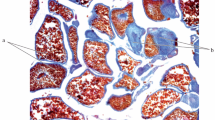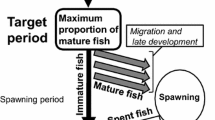Abstract
The variation of oocytes of initial phases of vitellogenesis in two forms of Baikal grayling Thymallus baicalensis was studied. The dependence of their diameter on the size-age indices of females, as well as differences in the sizes of oocytes between the studied forms, was established. Comparison of oocytes of identical forms of development revealed that oocytes of the white grayling during termination of the phase of cytoplasm vacuolization and at the beginning of the phase of yolk accumulation have a smaller diameter of the cell, of the nucleus, respectively, and of yolk granules and a greater, with respect to cell diameter, size of vacuoli. The revealed differences of morphological characteristics of oocytes of initial phases of vitellogenesis in combination with the well-known, stably smaller (by a factor of 1.5) size of mature eggs of the white Baikal grayling that matures at a later age at larger sizes indicate a profound adaptive diversification in the course of development of the reproductive system of both forms.
Similar content being viewed by others
References
Annotated Catalog of Cyclostomata and Fish from Continental Waters of Russia, Ed. by Yu.S. Reshetnikov (Nauka, Moscow, 1998) [in Russian].
Atlas of Freshwater Fish of Russia, Vols. 1–2, Ed. by Yu. S. Reshetnikov (Nauka, Moscow, 2002), Vol. 1 [in Russian].
T. N. Belyanina, “Some Comparative Data on the Biology of Small-Sized Smelt (Snetok) and Smelt,” in Regularities of Growth and Matutation of Fish (Nauka, Moscow, 1971), pp. 153–168.
L. S. Berg, Freshwater Fish of the USSR and Adjacent Countries, 4th ed. (Akad. Nauk SSSR, Moscow, 1948), Part 1 [in Russian].
D. A. Chmilevskii, “On Periods of Oogenesis of Teleostei (A Review),” Vopr. Ikhtiol. 43(3), 375–387 (2003) [J. Ichthyol. 43 (4), 296–307 (2003)].
N. I. Chugunova, Guide for Study of Age and Growth of Fish (Sov. Nauka, Moscow, 1959) [in Russian].
E. A. Dorofeeva, “The Genus Thymallus,” in Annotated Catalog of Cyclostomata and Fish from Continental Waters of Russia, Ed. by Yu.S. Reshetnikov (Nauka, Moscow,1998).
E. A. Dorofeeva, “The Genus Thymallus, in Atlas of Freshwater Fish of Russia,” Ed. by Yu.S. Reshetnikov (Nauka, Moscow, 2002), Vol. 1, pp. 163–169.
V. Ch. Dorogostaiskii, “Vertical and Horizontal Distribution of Fauna in Lake Baikal,” Tr. Prof. Prepodavat. Irkutsk Gos. Univ., No. 4, 1–31 (1923).
A. G. Egorov, Fish of Water Bodies of Eastern Siberia (Petromyzontidae, Acipenseridae, Salmonidae, Coregonidae, Thymallidae, Esocidae) (Irkutsk. Knizh. Izd-vo, Irkutsk, 1985) [in Russian].
Z. I. Galkina, “Dependence of the Size of Eggs on the Size and Age of Female Salmonids-Salmo salar L. and Salmo irideus Gib,” Vopr. Ikhtiol. 10(5), 826–837 (1970).
N. L. Gerbil’skii, “The Study of Functional Bases of Intraspecific Evolution in Relation to the Problem of Abundance and Range in Fish Management,” Vestn. Leningr. Gos. Univ., Ser. Biol., No. 15, 5–21 (1967).
V. O. Gratsianov, “Ichthyofauna of Baikal,” Izv. O-va Lyubit. Estestvozn., Antropol. Etnograf. 97(3), 18–61 (1902).
V. N. Ivankov, Structure of Ovicells and Fish Systematics (DVGU, Vladivostok, 1987) [in Russian].
V. N. Ivankov and E. G. Maksimova, “Comparative Analysis of the Structure of Ovicells in Thymallidae and Salmonidae and Close Relationship Between Fish in the Suborder Salmonidaei,” Vopr. Ikhtiol. 32(32), 59–66 (1992).
B. N. Kazanskii, “Specific Functions of Ovary and Hypophysis in Fish with Multiple Spawning,” Tr. Labor. Osnov Rybovodstva 2, 64–121 (1949).
I. B. Knizhin, S. J. Weiss, and S. Sushnik, “Graylings of Baikal Lake Basin (Thymallus, Thymallidae): Diversity of Forms and Their Taxonomic Status,” Vopr. Ikhtiol. 46(4), 442–459 (2006) [J. Ichthyol. 46 (6), 418–435 (2006)].
M. T. Koskinen, I. Knizhin, C. R. Primmer, et al., “Mitochondrial and Nuclear DNA Phylogeography of Thymallus spp. (Grayling) Provides Evidence of Ice-Age Mediated Environmental Perturbations in the World’s Oldest Body of Freshwater, Lake Baikal,” Mol. Ecol. 11, 2599–2611 (2002).
S. G. Kryzhanovskii and Z. M. Pchelina, “On the Principle of Structure of the System of Gobies from the Family Gobiidae,” Zool. Zh. 3, 446–454 (1941).
Yu. K. Kuznetsov, “On Functional Bases of Adaptive Radiation within the Species Osmerus eperlanus (L.),” Vopr. Ikhtiol. 4(3), 453–462 (1964).
Yu. K. Kuznetsov, K. V. Gorchinskii, and O. V. Romanyuk, “Comparative Analysis of the Function of Ovaries in Forms of the Species Osmerus eperlanus (L.) Differing in the Rate of Sexual Maturation,” Tr. Nauchno-Issled. Inst. Ozern. Rechn. Rybn. Khoz., No. 183, 28–57 (1982).
G. F. Lakin, Biometry. Educational Aid for Universities and Pedagogical Institutes (Vysshaya Shkola, Moscow, 1973) [in Russian].
E. G. Maksimova, “Specific Features of Structure of Ovicells in the Siberian Grayling Thymallus arcticus During Vitellogenesis,” Vopr. Ikhtiol. 31(2), 300–305 (1991).
V. A. Meien, “On Causes of Fluctuations in the Size of Eggs of Bony Fish,” Dokl. Akad. Nauk SSSR 28(7), 655–656 (1940).
K. I. Misharin, “On the Biology of Eggs and Juveniles of Some Commercial Fish from Lake Baikal and the Angara River,” Tr. Vost.-Sib. Irkutsk Gos. Univ., Ser. Biol. 2(3), 89–119 (1942).
K. I. Misharin, Fish and Fishery in Irkutsk Oblast (Irkutsk. Obl. Izd-vo, Irkutsk, 1950) [in Russian].
G. V. Nikolsky, Theory of Dynamics of Fish School (Nauka, Moscow, 1965) [in Russian].
K. Pivnicka and K. Hensel, “Morphological Variation in the Genus Thymallus Cuvier, 1829 and Recognition of the Species and Subspecies,” Acta Univ. Carolinae-Biologica 1975–1976 4, 37–67 (1978).
P. A. Plokhinskii, Algorithms of Biometry (Mosk. Gos. Univ., Moscow, 1980) [in Russian].
I. F. Pravdin, Guide for Fish Study (Pishch. Prom-st’, Moscow, 1966) [in Russian].
T. S. Rass, “On Types of Structure of Eggs and Their Importance for Classification of Fish,” Dokl. Akad. Nauk SSSR 2(2)(7(93), 299–302 (1936).
T. S. Rass, “On the Taxonomic Importance of the Size of Eggs of Bony Fish (Teleostei),” Byull. Mosk. O-va Ispyt. Prir. Otd. Biol. 54(6), 11–20 (1947).
B. Romeis, Microskopische Technik (Oldenbourg, München, 1948).
O. F. Sakun, “Transition to Meiotic Division of Oocytes with an Uncompleted Vitellogenesis Under the Effect of Hormonal Stimulation in Atlantic Salmon Salmo salar L.,” Dokl. Akad. Nauk SSSR 169(1), 241–244 (1966).
V. G. Sideleva, The Endemic Fishes of Lake Baikal (Backhuys Publ., Leiden, 2003).
S. G. Soin, “On Reproduction and Development of the Black Baikal Grayling (Thymallus arcticus baicalensis Dybowski),” Zool. Zh. 42(12), 1817–1839 (1963).
A. N. Svetovidov, “Materials on Systematics and Biology of Graylings from Lake Baikal,” Tr. Baikal. Limnol. Stn. 1, 19–199 (1931).
A. N. Svetovidov, “European-Asian Graylings (Genus Thymallus Cuvier),” Tr. Zool. Inst. Akad. Nauk SSSR 3, 183–301 (1936).
D. N. Taliev, Gobies from Baikal (Cottoidei) (Akad. Nauk SSSR, Moscow, 1955) [in Russian].
P. Ya. Tugarina, “Baikal Graylings,” in Fish and Fish Management in the Baikal Basin (Irkutsk. Obl. Izd-vo, Irkutsk, 1958), pp. 311–333.
P. Ya. Tugarina, Graylings of Baikal (Nauka, Novosibirsk, 1981) [in Russian].
P. Ya. Tugarina, “Thymallidae of Largest Lakes of Central Asia,” Tr. Kaf. Zool. Pozvonoch. Irkutsk Gos. Univ. 1, pp. 114–127 (2001).
P. Ya. Tugarina and Zh. A. Chernyaev, Instruction for Artificial Cultivation of Grayling (Irkutsk. Obl. Izd-vo, Irkutsk, 1961) [in Russian].
S. G. Vasetskii, “On Regularities of Change in the Size of Eggs of Ripe Female Caspian Roach,” Tr. Inst. Morfol. Zhivotn. Akad. Nauk SSSR, No. 40, 254–266 (1962).
S. Weis, I. Knizhin, V. Romanov, and T. Kopun, “Secondary Contact between Two Divergent Lineages of Grayling Thymallus in the Lower Enisey Basin and Its Taxonomic Implications,” J. Fish Biol. 71, 371–386 (2007).
V. N. Zhukinskii and I. E. D’yachuk, “Dependence of Biometrical Indices of Ovulated Eggs on Some Biological Indices of Female Azov Roach and Rudd,” Vopr. Ikhtiol. 4(2)31), 292–303 (1964).
Author information
Authors and Affiliations
Corresponding author
Additional information
Original Russian Text © A.N. Zaitseva, N.S. Smirnova-Zalumi, N.I. Zakharova, 2008, published in Voprosy Ikhtiologii, 2008, Vol. 48, No. 6, pp. 782–789.
Rights and permissions
About this article
Cite this article
Zaitseva, A.N., Smirnova-Zalumi, N.S. & Zakharova, N.I. Morphological variation of oocytes of initial phases of vitellogenesis in two forms of Baikal grayling Thymallus baicalensis (Thymallidae). J. Ichthyol. 48, 751–758 (2008). https://doi.org/10.1134/S0032945208090063
Received:
Published:
Issue Date:
DOI: https://doi.org/10.1134/S0032945208090063




